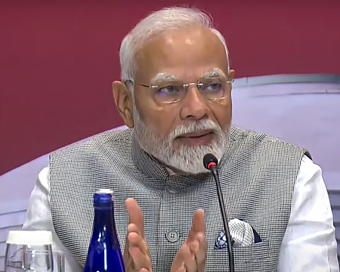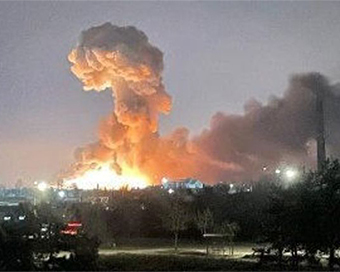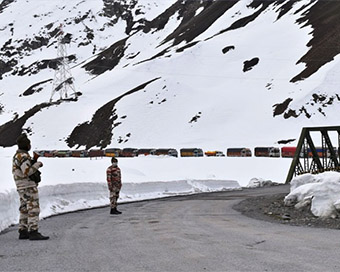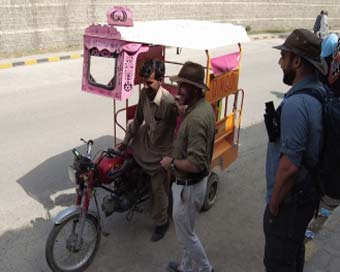Gallery
 PM Modi visit USA
PM Modi visit USA Only the mirror in my washroom and phone gallery see the crazy me : Sara Khan
Only the mirror in my washroom and phone gallery see the crazy me : Sara Khan Karnataka rain fury: Photos of flooded streets, uprooted trees
Karnataka rain fury: Photos of flooded streets, uprooted trees Cannes 2022: Deepika Padukone stuns at the French Riviera in Sabyasachi outfit
Cannes 2022: Deepika Padukone stuns at the French Riviera in Sabyasachi outfit Ranbir Kapoor And Alia Bhatt's Wedding Pics - Sealed With A Kiss
Ranbir Kapoor And Alia Bhatt's Wedding Pics - Sealed With A Kiss Oscars 2022: Every Academy Award Winner
Oscars 2022: Every Academy Award Winner Shane Warne (1969-2022): Australian cricket legend's life in pictures
Shane Warne (1969-2022): Australian cricket legend's life in pictures Photos: What Russia's invasion of Ukraine looks like on the ground
Photos: What Russia's invasion of Ukraine looks like on the ground Lata Mangeshkar (1929-2022): A pictorial tribute to the 'Nightingale of India'
Lata Mangeshkar (1929-2022): A pictorial tribute to the 'Nightingale of India' PM Modi unveils 216-feet tall Statue of Equality in Hyderabad (PHOTOS)
PM Modi unveils 216-feet tall Statue of Equality in Hyderabad (PHOTOS)The Badminton Association of India (BAI) has announced a 14-member-strong India squad for
- Men’s Sr Hockey Nationals to be played in division-based format from April 4
- Mensik denies Djokovic 100th title in Miami final
- KIPG: Son of a vegetable vendor, Bihar’s Jhandu Kumar eyes Worlds, 2028 Paralympics
- Hardik Singh credits hard work and team unity for receiving HI Midfielder of the Year award
- Djokovic, Alcaraz land in same half of Miami draw
Bound by agreements, Indian soldiers did not use firearms against Chinese troops Last Updated : 19 Jun 2020 02:52:14 PM IST 
file photo The 20 Indian soldiers killed in the violent stand-off with China along the Line of Actual Control (LAC) in Galwan valley of Ladakh, did not use the firearms they were carrying as per the two bilateral agreements between India and China.
India's Foreign Minister S. Jaishankar on Thursday claimed that the Indian troops at Galwan valley on June 15 were carrying arms, as the soldiers on border duty always do, "especially when leaving post".However, he added that as per 1996 and 2005 agreements between India and China, the troops of both sides are "not to use firearms during face-offs".On June 15, clashes erupted between India and China in Galwan valley when an Indian patrol encountered Chinese soldiers in an area from where the Chinese had retreated from in line with a June 6 disengagement agreement.However, the Chinese troops as per reports, were carrying iron rods, batons wrapped in barbed wire and clubs embedded with nails and used them against Indian soldiers, which resulted in a hand-to-hand combat.After the Indians called for reinforcements from a post about two miles away, up to 600 men got engaged in combat using stones, batons, iron rods.According to Jaishankar, Indian soldiers refrained from using firearms because they were bound by the two bilateral agreements of 1996 and 2005.As per Article I of the 1996 agreement, "neither side shall use its military capability against the other side. No armed forces deployed by either side in the border areas along the Line of Actual Control as part of their respective military strength shall be used to attack the other side, or engage in military activities that threaten the other side or undermine peace, tranquility and stability in the India-China border areas".Article II of the same agreement says that pending an ultimate solution to the boundary question, the two sides will strictly respect and observe the LAC. "No activities of either side shall overstep" the LAC, the article says.The two sides, as per Article III, reaffirm that they shall reduce or limit their respective military forces within mutually agreed geographical zones along the LAC in the India-China border areas to "minimum levels" compatible with the friendly and good neighborly relations.The 2005 Indo-China agreement, as per Article I says, that the differences on the boundary question should not be allowed to affect the overall development of bilateral relations. "Neither side shall use or threaten to use force against the other by any means," Article I says.IANS New Delhi For Latest Updates Please-
Join us on
Follow us on








172.31.16.186







